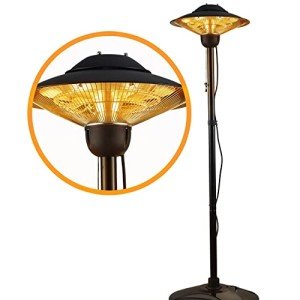How to Choose a Patio Heat Lamp Electric

When you want to heat your patio, you've got many options. Electric heaters are much more convenient than propane models, which require fuel refills. They can be heated immediately by pressing a button or flicking a switch.
They also don't release gasses that might pose a health risk. Some models have adjustable temperature settings for different distances.
Type of Heater
With the right patio heater, you can comfortably relax in your outdoor living spaces into the night and across the seasons. Patio heaters come in many varieties, including freestanding propane or natural gas models, as well as wall- or ceiling mounted electric radiant heaters. Your choice will depend on the dimensions of the space, the power sources available and personal preference.
The majority of patio heaters use electricity, natural or liquid gas to generate heat. They emit heat via convection heating as well as radiant heating. Their heat output is measured in watts and can be converted to British thermal units (BTUs) to compare. Some models have adjustable heating settings for greater flexibility.
Patio heat lamps combine an electric burner on a pole with an aperforated screen that reflects flames and sends heat downwards to warm objects, people and furniture. Some come with an reflector on top of the burner, which can be silvered to cut down the amount of heat emitted upwards.
Gas patio heaters are the most common patio heaters. patio electric heater are able to heat multiple tables quickly and evenly. These patio heaters are portable and can be powered by a propane tank or connected to your natural gas line. This is more convenient and comes with lower upfront costs, but requires fuel.
Gas patio heaters are becoming increasingly popular as more houses have natural gas lines. These heaters are easy to install, however they require a gas line that's properly installed and working to be secure. There are portable natural gas heaters with extension hoses that aid in overcoming this issue however they could be a risk of tripping and a fire risk when not being used.
Safety
Electric patio heaters are safe to use in enclosed areas, since they permit heat to radiate upwards and not outwards. However, they're not designed to be used on an open roof. The heater should be placed at least 18" from adjacent walls or 6" from the ceiling to avoid fire hazards.
Gas and propane patio heaters are usually safe to be installed in enclosed areas and are protected by an enduring cover designed for open-air use. They are usually constructed of fire-retardant fabric and have a roof that can be closed. These types of patio heaters pose safety concerns relating to the flames and fumes they create. They should be kept away from any objects that could ignite, such as chairs and curtains.
Follow the safety and instructions guidelines of the manufacturer when installing a patio heater or heat lamp. Choose a system that has UL and CSA safety certifications. Also, be sure to read the owner's manual thoroughly. Be especially careful when it comes to pets and children, and ensure that the heater isn't in their reach while it's operating. Some patio heaters that are freestanding like EUROM's include a tipping safety feature that shuts off the device if it falls.
If your patio heater is connected to a natural gas line it is essential to inspect the condition of the line regularly and test it for leaks by an experienced professional. If the line requires to be replaced, make sure to hire an authorized plumber. A professional can determine whether the line is properly routed or if it should be routed through an underground pipe. A professional can also make sure the heater in the patio is plugged into an outlet that's GFCI (ground fault circuit interrupter) rated to protect against electrical shocks and fires.
Installation
The size of the patio heater is positioned determines how much heat it will radiate into the area. It is crucial to place the heater in a safe distance from surfaces such as plastic which can deform and wood, which can get too hot. It is possible to mount the heater on a wall, structure or any other surface using traditional mounting brackets. Certain models come with a soft start, which decreases the peak current to protect your circuits.
